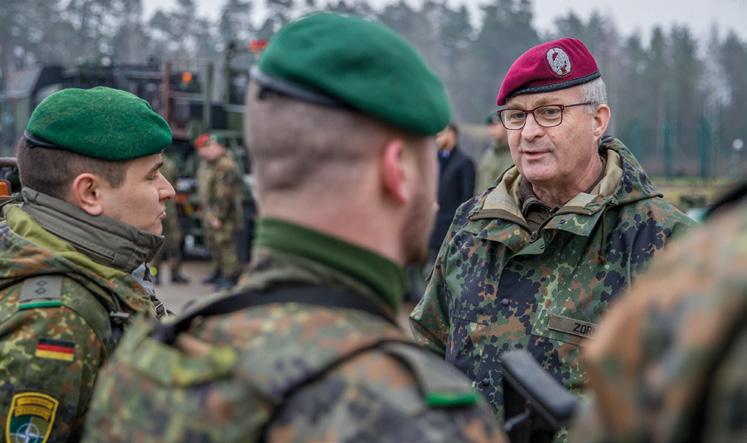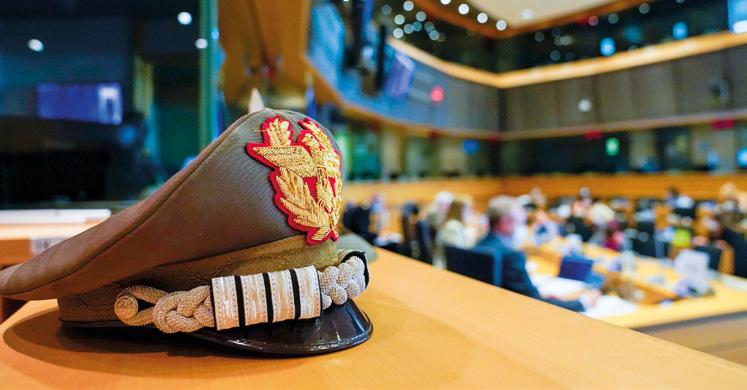
6 minute read
Cyrille Schott, Paris Security and defence, both interdependent sides of the same coin The crisis ultimately moves the lines
Security and defence, both interdependent sides of the same coin
It is the crisis that ultimately moves the lines
by Cyrille Schott, Préfet (h.) de région, Member of the Board of EuroDéfense France, Paris
Security occupied the minds of Europe’s founding fathers: “Never again war!” However, they pragmatically focused on the economy, creating the European Coal and Steel Community, followed by the European Economic Community in the Treaty of Rome in 1957. The failure of the European Defence Community (EDC) leading to the handing over, through NATO, of the defence of Europeans to the United States, means that the project of European defence cannot then succeed. Europe is moving forward in peace, with America protecting. When the iron curtain collapsed, western and eastern Europe met again. The Community becomes the European Union (EU) in 1992. If we believe then in the “end of history” and the triumph of liberal democracy, war reappears at the gates of the Union: in former Yugoslavia, in the Caucasus, in Ukraine. And Europeans perceive the rise of threats: in the east, there is concern about the Russian attitude, in the south we feel the terrorist threat, the worrying destabilisation of the Middle East and Libya, Turkish aggressiveness, the fear of new waves of migration, the fear of cyber-attack is everywhere. Europe is discovering an America looking towards the Pacific and preferring to discuss with each of the European nations in isolation, in a position of weakness, and not with the global economic power that forms a united Europe. The other continent-states, China, Russia, would also like to deal with a fragmented Europe. With Donald Trump not hesitating to call it a commercial “enemy”, the Union can no longer claim to be progressing in the shadow of the American umbrella. For the “miracle of peace” to continue, we must now have “a Europe that protects”. The issue of security and defence is gradually at the heart of the European agenda.
Significant progress in internal security
Internal security is progressing. The implementation of the Schengen Convention, signed in 1985, was a decisive step. The decision to open internal borders to the free movement of people was accompanied by “compensatory measures” to combat crime: the development of police, customs and judicial cooperation; the creation of a database of persons and sought objects. Schengen cooperation will be a laboratory for European integration in the field of security. After Schengen, the Maastricht Treaty created in 1992 the “justice and home affairs” pillar, which is based on intergovernmental cooperation, the Amsterdam Treaty, in 1997, establishes the “area of freedom, security and justice”, and the Treaty of Lisbon, in 2007, marks another major moment, by abolishing the pillar structure and thus generalising the Community method and giving some power to the supranational institutions in this area. Cooperation between police forces is now close and is based on the Europol agency, created in 1995. Europol has more than 1,000 staff, welcomes 220 liaison officers and supports more than 40,000 cross-border investigations annually. Cooperation in criminal matters has continued to grow, with the assertion
of the Eurojust agency created in 2002, the mutual recognition of court decisions, and effective instruments, such as joint
investigation teams or the European Arrest Warrant, in force since 2004. The European Criminal Records Information System (ECRIS) has been connecting databases containing criminal records since 2012. The Schengen Information System (SIS) contains 91 million records at the end of 2019, relating to persons or stolen and searched objects, and has been accessed 6.6 billion times. Frontex, which has been in operation since 2005 and became, in response to the migration crisis, the European Border and Coast Guard Agency in 2016, must have within a few years a contingent of 10,000 border and coastguards in order to help European countries with border control and migration management.
Advances in defence Defence, for its part, has made progress. Since the Maastricht Treaty and the Petersberg Declaration in 1992, Europe has had a Common Foreign and Security Policy (CFSP). In 1999, after the Franco-British summit in Saint-Malo, the foundations of a European defence policy were laid, with the first two military operations launched in 2003. Thus, the European Security and Defence Policy (ESDP), which in 2009 with the Lisbon Treaty became the Common Security and Defence Policy (CSDP), the armed branch of the CFSP, was born. In 15 years, nearly 80,000 men have been engaged in EU operations. 36 military, civilian and civil-military missions have been deployed, 17 of which are currently underway on three continents: six are military, such as the naval operation against piracy on the Somali coast, 11, like Eulex in Kosovo, are civilian, police and support to the security forces or the rule of law, border assistance. These so-called ‘low-spectrum’ operations, however, corre-
spond to a limited commitment and are not the expression of a genuine European defence, capable of taking strong action to protect Europe or its interests in the world. Concerning the defence of the continent itself, most Member States see it continuing to be based on NATO and American commitment. Since Brexit, important new developments have emerged: the creation of a Military planning and conduct capability (MPCC); the coordinated annual review on defence (CARD); the permanent structured cooperation (PESCO) to develop the capabilities of Member States’ armies; the European Defence Fund (EDF), which introduces defence into the European budget; and finally the European Intervention Initiative (EI2) – outside of institutions – to strengthen operational cooperation
between partner states and the UK. The two sides of sovereignty
Although the civilian and the military may have been linked in external operations, this brief reminder reveals two parallel but separate paths. The awareness of the link between internal and external security, between security and defence, however, is growing and is expressed in the most recent texts of the Union. Thus, in 2016, in A Global Strategy for the European Union’s Foreign and Security Policy, it is written: “The European Union will promote peace and guarantee the security of its citizens and territory. Internal and external security are ever more intertwined.” In July 2020, in the Communication from the Commission on the EU security union strategy, which follows the programmes and the EU internal security strategies, agreed in the wake of
Cyrille Schott
is a retired French regional prefect. Born in 1950, he earned an MA in history from the Sorbonne (Paris), and holds a diploma from the Institut d’Etudes Politiques of Strasbourg and from the French national administration school ENA. From 1982-1987, Mr Schott was an advisor to the office of President Mitterrand.
Photo: private
Thereafter he started his prefectural career in Belfort, followed by five appointments as a departmental prefect and two as a regional prefect. After his appointment as a Chief Auditor in the Cour des comptes (audit office), he ended his career as the director of the National Institute for Advanced Security and Justice Studies (INHESJ). He is a reserve colonel. the 1999 Tampere Declaration, it is said: “Protecting the Union and its citizens is no longer only about ensuring security within the EU borders, but also about addressing the external dimension of security. The EU’s approach to external security within the framework of the CFSP and the CSDP will remain an essential component of EU efforts to enhance security within the EU.” The fight against terrorism and stabilisation actions in states outside the Union, but important for its security, underline, among others, that internal security and defence are elements of the same global strategy.
→ Continued on page 20










